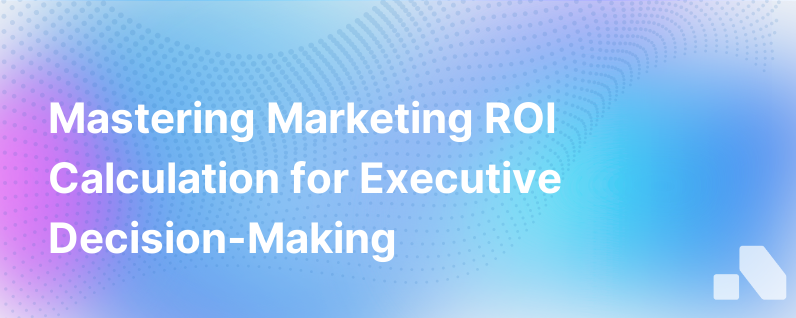
Calculating marketing ROI is akin to navigating a complex maze- fraught with blind turns and unforeseen obstacles, but the end is rewarding. It is the critical calculation of the return on investment that emerges from dollars shelled out on marketing efforts. This monetary evaluation stamps its authority over other metrics to reveal the story behind each penny invested in your marketing crusades.
However, an accurate ROI calculation demands a precise compass and a reliable map, which, in the business realm, translates to the right formulas and the complete assimilation of necessary data points. Ideally, ROI is a simple percentage that tells you the increase (or decrease) in the total revenue in relation to the cost of the investment.
To start demystifying this elusive metric, let’s begin with the most fundamental formula:
ROI = (Net Profit / Cost of Investment) x 100
Simple, right? But as with all things marketing, the devil is in the details.
Delineating 'Net Profit'
Net profit should reflect the revenue generated from marketing subtracted by the cost of goods sold (COGS) and the total marketing spend. Complications arise when you aim to trace every revenue dollar back to its corresponding marketing activity. Attribution can be your ally and adversary in this tale, for not all purchases are straightforwardly linked to a single campaign, especially in a buyer’s journey crisscrossing online and offline touchpoints.
In a digitally-dominant world, enterprises lean heavily on web analytics tools, like Google Analytics, which track online conversion paths with relative ease, tying various touchpoints to a final sale through models like last-click, first-click, or multi-touch attribution.
However, the real challenge surfaces when trying to value offline conversions, or more intricate online actions such as social media engagement or email open rates. Here, you must excavate deeper, often employing proxies for direct revenue or creating models that infer the financial value of these less tangible interactions.
The Nitty-Gritty of 'Cost of Investment'
The cost element should encompass all expenses related to the marketing effort in focus. This isn’t restrained solely to ad spend but sweeps across the marketing spectrum, to accommodate staff costs, agency fees, media buys, software subscriptions, and even overheads apportioned to marketing – like a fragment of the electricity bill for the marketing department’s lights.
It's critical to maintain granular tracking of these expenses to prevent your ROI calculations from cascading into errors, contributing to misguided strategic decisions.
Also, remember timing is crucial; align the expenditure timeframe with its corresponding revenue effects. A campaign's costs today might not manifest in revenue until the next quarter, for instance.
The Agility of Running 'Calculations Over Time'
ROI is not a 'set it and forget it' affair. As with any quantitative analysis, time is a formidable dimension. A month-on-month analysis might paint an entirely different picture compared to an annual overview due to seasonality, market trends, or even a viral campaign that skewers data points temporarily.
Furthermore, due diligence must be paid to the customer lifetime value (CLV). It extends the lens further to encapsulate the total net profit attributed to the entire relationship with a customer. This is particularly salient for subscription-based models or industries where repeat purchases are the norm. The upfront acquisition cost may dwarf in comparison to the long-term revenue generated by a customer.
Finessing the Art with 'Soft Metrics'
Sometimes, the focus sharpens on 'soft' metrics—brand awareness, customer satisfaction, or thought leadership—which don’t immediately translate to sales but sew the seeds for ROI in the foreseeable future. Here, the ROI doesn’t break the surface instantly but bubbles beneath as potential for conversions.
Soft metrics require strategic patience and a diversified approach to ROI calculation. You might resort to surveys to gauge brand recognition before and after a campaign or infer future sales from social media engagement growth rates.
Taking on the Challenge with 'Holistic Tools'
Amidst this calculative odyssey, platforms like HubSpot or Marketo can play the role of your cartographer, stitching together disparate data points to offer a unified dashboard of your marketing activities and their ROI. Advanced features in these tools take into account multi-touch attribution, offer CLV analyses, and can even integrate soft metrics into the equation.
Nurturing Decisions with 'Data-Driven Insights'
With ROI decoded, you unravel profound insights that guide where to allocate your future marketing spend. Do you double down on high ROI channels, or revamp those lagging? Do you refocus your marketing efforts to earlier stages of the buyer’s journey, or the closing phases?
Remember, ROI isn't just about the hard numbers—it represents customer preferences, effective messaging, successful channel utilization, and above all, the resonance of your brand within the market landscape.
Ultimately, calculating marketing ROI is less about reaching a finite conclusion and more about embarking on an iterative, revelatory process—a trek through the ever-shifting marketing underbrush where the path to clarity is paved with both numbers and narratives.
Wrapping It Up
Despite its complexity, calculating marketing ROI is indispensable in today's data-driven, competitive marketplace. It brings a quantitative backbone to marketing’s often qualitative spirit. Armed with the knowledge of ROI, you can prudently dictate the future course for your marketing endeavors, ensuring each dollar is not just spent, but invested, with sagacious intent.
In the grand scheme of B2B sales and marketing, tools like Aomni can streamline this process to some extent, by providing actionable insights and aligning sales efforts with marketing initiatives – allowing for a more cohesive understanding of ROI as it pertains to the entire lifecycle of the customer.